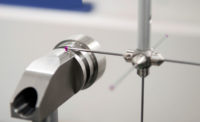Better Inspection Reporting Saves Time
Saving time is always helpful, and inspection reports are no different.

Inspection reports that take less work can be a great way for an organization to save time and money. Manufacturers have always been interested in being efficient, but during these uncertain times, it makes more sense than ever.
Software vendors say that clients are increasingly asking about how much time the software will save, as many manufacturers have locations with fewer employees trying to do the same amount of work. It’s the age-old “do more with less” struggle.
But it doesn’t have to be such a slog if you find the right approach.
If you can spend less time doing something and get the same results, why not? (Witness the appeal of the four-hour workweek and nine-minute workouts.)
Rushing your critical inspections is obviously not the answer, however. In a range of industries, from aerospace to medical, quality cannot be hurried. Aerospace, for example, requires first article inspections that can be time-consuming depending on your process.
Let’s take a closer look at the first article inspection process in order to understand what needs to be done.
BSI explains it this way: “First Article Inspection (FAI) is an essential part of quality control in aerospace manufacturing. Its purpose is to provide objective evidence that all engineering design and specification requirements are properly understood, accounted for, verified, and documented. The standard that governs this is AS 9102, the Aerospace Standard for First Article Inspection Requirements. FAI ensures reliability and repeatability of the manufacturing process, as well as ensuring the manufacturer’s ability to produce parts according to customer specifications.”
According to Q-PLUS Labs, “First article inspection is an important component of successful manufacturing. The first article in production must be inspected, or measured, to determine whether it meets the engineering specifications. If it does not, corrective steps must be taken. These steps take time and money, which is why first article inspection must be quick and accurate.”
“Getting production right the first time does not always happen in manufacturing, but getting first article inspection right the first time is not only possible, but also essential.”
In other words, manufacturing a high-quality product from the start is always a good idea—rework has never been a time-saver—but inspection done right is also critical.
When should these be done? According to Jesse Garant Metrology, “FAI reports are necessary when one of the following occur:
- A change in design which can potentially affect fit, form or function
- A change in manufacturing source, process, inspection method, location of manufacturer, tooling or materials
- A change to a different media program that can potentially affect fit, form or function
- Production of this part has not been executed for two years or more (or as specified by customer)”
So clearly first article inspection is important. Speeding up the process is helpful as long as it doesn’t come at quality’s expense. How would a faster process happen? There are a few ways to go about it. The advantages, according to Space Coast Daily, include: increased efficiency, timely delivery, fewer mistakes, quality assurance, easy to handle, and cost-efficient.
It boils down to the idea that doing a report right the first time helps streamline the process, prevent errors, and saves money on unnecessary labor costs.
In terms of quality assurance, Space Coast Daily continues, “It is very easy to overlook one of the requirements during the first article inspection, but with the help of the FAI software, this doesn’t need to happen. It controls and helps reduce quality escapes, which happen because of ignoring or overlooking some of the requirements. This means that you won’t get as many FAI rejections, and your productivity will improve over time because the job is being done on time and it is being done properly.”
Let’s take a look at how this might work in practice.
TECT Corp. is one company that has found immediate benefits in using first article inspection software. They currently serve the following markets: aerospace gas turbines, industrial gas and steam turbines, marine turbines, and space launch vehicles. As the company says, “Whether you’re powering a plane, rocket, train or boat, TECT Power has the turbine engine manufacturing support you need.”
Quality is a serious matter in these industries—no one is going to be cavalier about quality during a space launch—and tight tolerances are critical.
When the company began to do first article inspections, they found that the right software was invaluable. They ended up going with DISCUS, a decision they found helpful, as stated in a case study. “TECT Manufacturing now doesn’t have to wait for Quality to complete all of the necessary paperwork; it’s done within hours of receiving a completed process from Engineering. The ability to reuse AS9102-compliant data within a structured, yet flexible tool allows TECT to adapt the information to match their needs.”
Whatever solution you choose, it should help with your first article inspections. Even if your organization feels stretched to the limit, making smarter choices can help get things done.
Looking for a reprint of this article?
From high-res PDFs to custom plaques, order your copy today!






